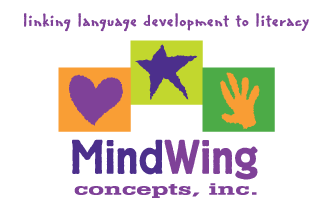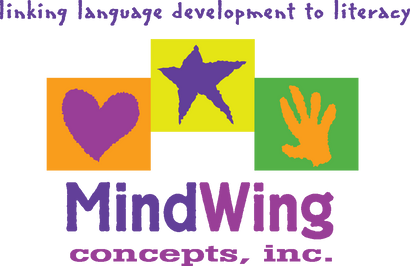Secure Checkout. FREE SHIPPING for Continental U.S. Orders over $60.
Menu
-
- Home
-
About Us
-
The Approach
-
Linking Language & Literacy
-
MindWing Learning
-
Learning Resources
-
SHOP
-
Blog
-
- About MindWing
- Our People
- Contact Us
- Your Account
- Login
-
United States (USD $)

Secure Checkout. FREE SHIPPING for Continental U.S. Orders over $60.

Tech Tuesday: Teaching through the Thought Bubble
November 22, 2022
 Picture books are one of our best and most engaging narrative teaching tools, and I love especially when I find a series to share with my students—and you! Series books allow for special opportunities to establish flow (both contextual and psychological) with similar character behaviors, narrative patterns, and themes. I have long been an admirer of author/illustrator Jon Klassen due to the power of his minimalist illustrations, which are beautiful but also witty, and establish character emotion primarily through exaggerated eye expressions. Recently I discovered he had illustrated a trilogy with Mac Burnett now called the Shape Trilogy, consisting of (in this order, which actually is important), Triangle, Square, and Circle. In these books, we can follow the antics of several shape characters as they interact with friends.
Picture books are one of our best and most engaging narrative teaching tools, and I love especially when I find a series to share with my students—and you! Series books allow for special opportunities to establish flow (both contextual and psychological) with similar character behaviors, narrative patterns, and themes. I have long been an admirer of author/illustrator Jon Klassen due to the power of his minimalist illustrations, which are beautiful but also witty, and establish character emotion primarily through exaggerated eye expressions. Recently I discovered he had illustrated a trilogy with Mac Burnett now called the Shape Trilogy, consisting of (in this order, which actually is important), Triangle, Square, and Circle. In these books, we can follow the antics of several shape characters as they interact with friends.

Tech Tuesday: Internalizing Icons!
September 27, 2022
 Story Grammar Marker® provides visual support for understanding and forming narrative, but part of its work depends on students ascribing meaning to its icons. Helping students internalize these visuals, their connections and meanings can take some review, and the more fun, the better! Here are a few tech-infused ways to drill-play the SGM® icons! Use a Slideshow! Google Slides can be a great way to make a digital “manipulative” for review. Pick a personal narrative or reviewed story to talk through, then use the Slideshow mode as a “quiz” on the icons alone or linked to contextualized story elements (e.g. “Kick-Off- the Bear’s kick-off was that someone stole his hat!”)...
Story Grammar Marker® provides visual support for understanding and forming narrative, but part of its work depends on students ascribing meaning to its icons. Helping students internalize these visuals, their connections and meanings can take some review, and the more fun, the better! Here are a few tech-infused ways to drill-play the SGM® icons! Use a Slideshow! Google Slides can be a great way to make a digital “manipulative” for review. Pick a personal narrative or reviewed story to talk through, then use the Slideshow mode as a “quiz” on the icons alone or linked to contextualized story elements (e.g. “Kick-Off- the Bear’s kick-off was that someone stole his hat!”)...

Tech Tuesday/Summer Study Series: The Moral of the Story is…
June 27, 2022
 As someone who loves themes and context, I was thrilled to find a particular study on assessment and intervention with FABLES to include as this entry in the 2022 Summer Study Series! This resource made me think back to last year’s discussion of using moral dilemmas in narrative language and social cognitive therapy activities. This post includes the advantage of having many adaptable materials to offer you! Specifically, we are talking about Philosophy for Adolescents: Using Fables to Support Critical Thinking and Advanced Language Skills (Nippold and Marr, 2022), an extensive article describing the authors’ work in assessing and intervening in language and critical thinking skills through fables...
As someone who loves themes and context, I was thrilled to find a particular study on assessment and intervention with FABLES to include as this entry in the 2022 Summer Study Series! This resource made me think back to last year’s discussion of using moral dilemmas in narrative language and social cognitive therapy activities. This post includes the advantage of having many adaptable materials to offer you! Specifically, we are talking about Philosophy for Adolescents: Using Fables to Support Critical Thinking and Advanced Language Skills (Nippold and Marr, 2022), an extensive article describing the authors’ work in assessing and intervening in language and critical thinking skills through fables...

Tech Tuesday/Summer Study Series: Narrative Meta-Analysis!
May 30, 2022
 With much of the USA wrapping up the 2021-22 school year, it’s time to embark on another summer study series. Naturally, each post will have a tech tie-in with a practical resource as well. First up, I was super excited to tell Maryellen and Sheila about a meta-analysis on narrative language interventions from October 2021 and have been eager to write about it here. A meta-analysis is considered among the highest levels of evidence and is a study of studies so to speak, applying criteria to include research on a topic and determining effect sizes of interventions. The study in question, Interventions Designed to Improve Narrative Language in School-Age Children: A Systematic Review With Meta-Analyses (Pico, Prahl, Biel, Peterson, Biel, Woods & Contesse) was published in ASHA’s Language, Speech and Hearing Services in Schools and is therefore available to all ASHA members, or ask your friendly SLP for a copy...
With much of the USA wrapping up the 2021-22 school year, it’s time to embark on another summer study series. Naturally, each post will have a tech tie-in with a practical resource as well. First up, I was super excited to tell Maryellen and Sheila about a meta-analysis on narrative language interventions from October 2021 and have been eager to write about it here. A meta-analysis is considered among the highest levels of evidence and is a study of studies so to speak, applying criteria to include research on a topic and determining effect sizes of interventions. The study in question, Interventions Designed to Improve Narrative Language in School-Age Children: A Systematic Review With Meta-Analyses (Pico, Prahl, Biel, Peterson, Biel, Woods & Contesse) was published in ASHA’s Language, Speech and Hearing Services in Schools and is therefore available to all ASHA members, or ask your friendly SLP for a copy...

Tech Tuesday: Make a Vocabulary “Story”
March 28, 2022
 Hello! You are here because stories are fun and engaging, right? Well, they also are strategic for teaching and learning. The National Council of Teachers of English(NCTE) states that story forms can aid in memory and recall across the curriculum: “Listeners encounter both familiar and new language patterns through story. They learn new words or new contexts for already familiar words.” It just makes sense! The context, engagement and emotional activation of a story can assist in any vocabulary related to that story. In this post, I’ll be detailing a number of tech- and non-tech resources for using vocabulary “stories.” Check out Beck, McKeowan, and Kucan’s Bringing Words to Life. This seminal vocabulary-teaching text discusses the concept of Tier 2 vocabulary words (robust words which link to concepts kids understand, such as the word final), and teaching them through context, kid-friendly definitions and word play.
Hello! You are here because stories are fun and engaging, right? Well, they also are strategic for teaching and learning. The National Council of Teachers of English(NCTE) states that story forms can aid in memory and recall across the curriculum: “Listeners encounter both familiar and new language patterns through story. They learn new words or new contexts for already familiar words.” It just makes sense! The context, engagement and emotional activation of a story can assist in any vocabulary related to that story. In this post, I’ll be detailing a number of tech- and non-tech resources for using vocabulary “stories.” Check out Beck, McKeowan, and Kucan’s Bringing Words to Life. This seminal vocabulary-teaching text discusses the concept of Tier 2 vocabulary words (robust words which link to concepts kids understand, such as the word final), and teaching them through context, kid-friendly definitions and word play.

Tech Tuesday: “Storyboard That!”
February 21, 2022
 Among the tech resources that can be helpful in narrative intervention are those that let you make your own story. Content creation apps and websites, often called “digital storytelling” tools (search Pinterest for many examples in this genre), provide great contexts for speech, language and literacy skill development for their ability to visualize story elements in cartoons or images. Digital storytelling tools can be employed in parallel with Story Grammar Marker® manipulatives, icons, and maps in a variety of ways: You make it: Create a product that you can “unpack” the story elements of with students, with SGM® playing a key scaffolding role, of course. We make it: Co-create with students by allowing them to make choices to construct a story, with you handling parts or all of the actual tapping or clicking to move things along. They make it: Often facilitated with you providing a model...
Among the tech resources that can be helpful in narrative intervention are those that let you make your own story. Content creation apps and websites, often called “digital storytelling” tools (search Pinterest for many examples in this genre), provide great contexts for speech, language and literacy skill development for their ability to visualize story elements in cartoons or images. Digital storytelling tools can be employed in parallel with Story Grammar Marker® manipulatives, icons, and maps in a variety of ways: You make it: Create a product that you can “unpack” the story elements of with students, with SGM® playing a key scaffolding role, of course. We make it: Co-create with students by allowing them to make choices to construct a story, with you handling parts or all of the actual tapping or clicking to move things along. They make it: Often facilitated with you providing a model...
